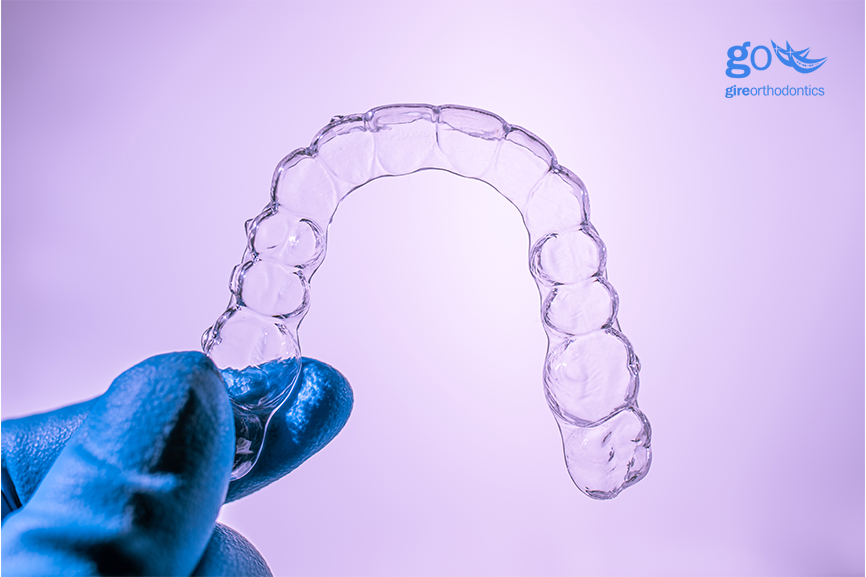
La Habra/Chino Hills, CA – Spark or Invisalign clear aligner therapy is a wonderful way for many orthodontic patients to get the smiles of their dreams. The aligners are clear, comfortable, and removable. When used properly they move teeth predictably and efficiently.
Sometimes, however, during the course of treatment a patient may find that their aligners aren’t tracking properly. Why might that happen and what does it mean for your treatment?
“We use the term tracking to refer to the proper fit of your aligners,” says Dr. Robert Gire. “If we say a patient has good tracking it means the aligners are closely following the shape of your teeth and the teeth are moving as they should according to your treatment plan. Poor tracking means your aligners aren’t fitting properly which means they can’t move your teeth in a predictable fashion.”
What could be the cause of this poor tracking?
- Your teeth just aren’t responding properly to the treatment. While we use high-tech computer models and software algorithms to plan your treatment out precisely, there is always one big variable – we can’t predict how your teeth are actually going to respond to treatment. Some people have stubborn teeth that just don’t want to be guided properly using the aligners. The software is sophisticated and it can move the teeth efficiently but it has a hard time determining how your tongue, cheeks, lips, and muscles will respond as well. Everyone’s mouth will respond differently and that holds true not only with aligners but with braces as well.
- You aren’t wearing your aligners as often as you should. This is by far the biggest reason why teeth don’t track as they should. To ensure your treatment stays on track, it’s important to wear your aligners a minimum of 20 to 22 hours per day. They should only be removed when eating, drinking anything other than water, brushing, and flossing. There is a lot of memory associated with the roots of the teeth and the surrounding structures and when the aligners are left out of the mouth for too long, the teeth will start to relapse back. This happens very quickly and that’s why we stress the importance of 20-22 hours per day.
- You’re skipping your chewing exercises. Chewing exercises help apply additional pressure that the aligners need to achieve their movements. Aligner chewies can push your Spark and Invisalign aligners onto your teeth to ensure a proper fit and help ensure predictable tooth movements.
- You decided to skip ahead to a new aligner set before your mouth was ready. You are given a series of aligner sets, each perfectly calibrated to achieve a certain movement. If you skip around or move too far ahead, you aren’t speeding up your treatment, you’re just creating a bigger issue.
- You don’t want to wear your aligner because your current set is gross. It’s important to take proper care of your aligners. Even though you only wear each set for less than two weeks, that’s still plenty of time for grime to build up on them. Be sure you are rinsing them every time you take them out, brushing them with a soft-bristled toothbrush and antibacterial soap, and soaking them when they aren’t in your mouth.
What should you do if you fall into one of the above categories?
“First, don’t panic,” says Dr. Gire. “Call our office as soon as you realize your aligners aren’t tracking properly so we can schedule an appointment. The sooner we can address the problem, the soon we can course-correct.”
If your aligners aren’t tracking because your teeth aren’t responding properly, there is a way to fix that. Dr. Gire can place small attachments or buttons if needed. Attachments can allow for a rubber band to be connected to certain teeth to provide the force needed. A button allows the aligner to grip better, making it easier for it to apply the needed force.
For other issues, Dr. Gire may recommend backtracking – that is, moving back a set of aligners to one that had an ideal fit. Your teeth may not have moved enough to warrant moving on to the next set yet, so backtracking can get you back on track. While aligners are pretty predictable with how it guides teeth, some movements tend to be more complex or sophisticated and those aligners may warrant longer wear. At Gire Orthodontics, we’ll demonstrate how you’ll know exactly when to transition to the next set of aligners.
It is also possible that you may need a revision to your treatment plan. This requires a visit to Dr. Gire in La Habra or Chino Hills, where he will take a new scan that can be used to formulate an updated treatment plan.
Dr. Gire is well-trained in Spark and Invisalign clear aligner therapy and has the knowledge and skill to help his patients navigate their treatment. If you are interested in learning more about Invisalign or are having issues with your treatment, call his office today at 562-690-1199 (La Habra) or 909-393-9911 (Chino Hills).


No Comments